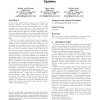Free Online Productivity Tools
i2Speak
i2Symbol
i2OCR
iTex2Img
iWeb2Print
iWeb2Shot
i2Type
iPdf2Split
iPdf2Merge
i2Bopomofo
i2Arabic
i2Style
i2Image
i2PDF
iLatex2Rtf
Sci2ools
CIKM
2007
Springer
2007
Springer
Leveraging context in user-centric entity detection systems
A user-centric entity detection system is one in which the primary consumer of the detected entities is a person who can perform actions on the detected entities (e.g. perform a search, view a map, shop, etc.). We contrast this with machine-centric detection systems where the primary consumer of the detected entities is a machine. Machine-centric detection systems typically focus on the quantity of detected entities, measured by precision and recall metrics, with the goal of correctly identifying every single entity in a document. However, the simple precision/recall scores of machinecentric entity detection systems fail to accurately reflect the quality of detected entities in user-centric systems, where users may not necessarily want to “see” every possible entity. We posit that not all of the detected entities in a given piece of text are necessarily relevant to the main topic of the text, nor are they necessarily interesting enough to the user to warrant further action. In fa...
| Added | 07 Jun 2010 |
| Updated | 07 Jun 2010 |
| Type | Conference |
| Year | 2007 |
| Where | CIKM |
| Authors | Vadim von Brzeski, Utku Irmak, Reiner Kraft |
Comments (0)

